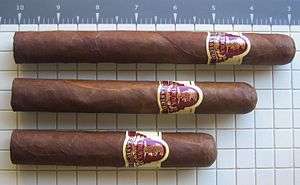Troya (cigar)
Troya is a U. S. brand of handmade premium cigar originally owned by Lignum-2, Inc. The brand in an old Cuban brand, established in 1932, but the Cuban version is now offered only as an all-machine-made brand of but two vitolas.[1]
History and background
This non-Cuban version of the Troya brand was introduced into the U. S. market in 1985.[2] The original medium-bodied blend was discontinued in 2003 and was replaced with a mild blend in 2004.[2] The line was further extended in 2004 with the introduction of a full-bodied cigar, the Troya X-Tra.[2]
Early 2007 saw the introduction of the Troya Clasico, a cigar blended and manufactured by Don Pepin Garcia at Tabacalera Cubana in Estelí, Nicaragua.[3] Don Pepin had been called upon earlier to aid in the development of the blends for both of the other Troya lines, which were the result of the efforts of several people.[4]
In mid-2008, the U. S. owner of the brand, Lignum2, Inc., was sold to Imperial Tobacco PLC, the world's fourth largest tobacco company,[5] which also owns Altadis, USA. Troya cigars are now manufactured in the facilities of Altadis.
This line is manufactured in the Dominican Republic.
Description
This line comes in two ranges, one with a Cameroon wrapper and the other with a Connecticut wrapper. The Cameroon is a medium-bodied cigar, while the Connecticut is a mild to medium cigar. The filler and binder in both are Dominican Piloto Cubano and Olor tobaccos. The cigars are presented in boxes of 24.
Models/Vitolas
| Frontmark | Vitola | Length (in.) | Ring Gauge |
|---|---|---|---|
| No. 36 | Perfecto | 4 | 50 |
| No. 72 | Mini belicoso | 5 | 52 |
| No. 81 | Belicoso | 6.125 | 52 |
| Frontmark | Vitola | Length (in.) | Ring Gauge |
|---|---|---|---|
| No. 27 | Corona | 5.5 | 42 |
| No. 54 | Toro | 5.75 | 48 |
| No. 45 | Cetro | 6.25 | 45 |
| No. 63 | Churchill | 7 | 50 |
Troya X-Tra
Formerly made in Estelí, Nicaragua,[2] this line is now manufactured in the Dominican Republic at the same factory as the Troya line above.[4]
Description
Although now made in the Dominican Republic, this line is a Nicaraguan puro. The X-Tra is a medium to full-bodied cigar. The filler is Criollo leaves, and the binder and wrapper are Corojo 99 from the Jalapá valley of Nicaragua. The cigars are presented in boxes of 24.
Models/Vitolas
| Frontmark | Vitola | Length (in.) | Ring Gauge |
|---|---|---|---|
| No. 18 | Robusto | 5 | 52 |
| No. 54 | Toro | 5.75 | 48 |
| No. 81 | Torpedo | 6.125 | 52 |
| No. 45 | Cetro | 6.25 | 45 |
| No. 63 | Churchill | 7 | 50 |
Troya Clasico

This line was introduced to the U. S. market in January 2007 as a limited edition release. The cigar was blended by Don Pepin Garcia and was manufactured at Tabacalera Cubana in Estelí, Nicaragua, until the sale of Lignum2 to Imperial Tobacco.
Description
This full-bodied cigar is a Nicaraguan puro using tobaccos grown in the Jalapá region of Nicaragua. The wrapper is a Corojo Oscuro and surround a binder and filler of Corojo and Criollo.[4] It is offered in boxes of 20 cigars.
Models/Vitolas

| Frontmark | Vitola | Length (in.) | Ring Gauge |
|---|---|---|---|
| XVIII | Robusto | 5 | 54 |
| LIV | Toro | 6 | 52 |
| LXIII | Churchill | 7 | 50 |
Notes
- "Profile of Cuban Troya". Perelman's Cyclopedia of Havana Cigars (online version). Archived from the original on 5 April 2007. Retrieved 25 March 2007.
- Pereleman, Richard B., comp. Perelman's Pocket Cyclopedia of Cigars, 2007 edn. Los Angeles: Perelman, Pioneer & Co., (2006), p. 500.
- Press release, Lignum-2, Inc., March 2007.
- Tom Irwin, Marketing Manager, Lignum-2, Inc. In litt., 3/23/2007.
- Gregory Mottola, Imperial Tobacco Acquires Lignum-2 Cigar Aficionado magazine, on-line edn., 11 June 2008. Retrieved 17 August 2017.